Hair Transplant for Thin Hair: Causes, Procedure & Benefits
Many men and women face hair thinning at some point and this change may come with age, genetics, hormones, or other conditions. It often lowers confidence and creates stress in social or work settings.
A hair transplant for thinning hair helps by moving strong hair from fuller areas of the scalp to places that have reduced volume. This method works well when done early and by trained professionals. It can restore hair growth and improve the appearance of the hairline.
In this guide, you will learn what causes hair thinning and who is a good candidate, the different techniques used and how recovery works. The guide will also include real changes people see in thin hair transplant before and after cases.
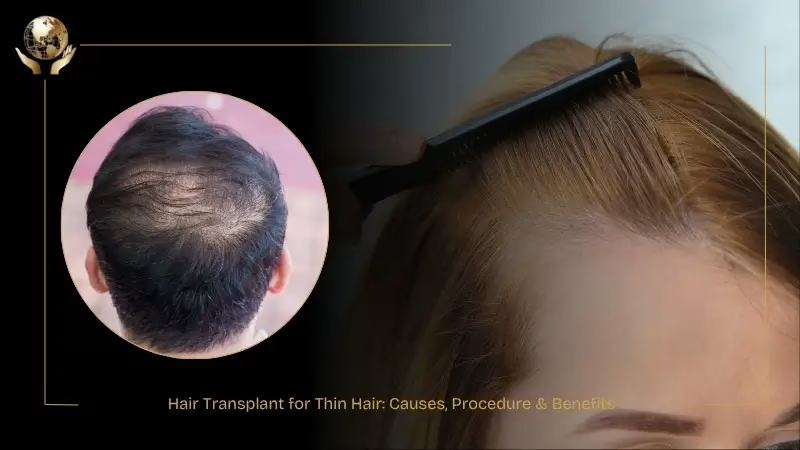
What Is Hair Thinning & Why It Happens
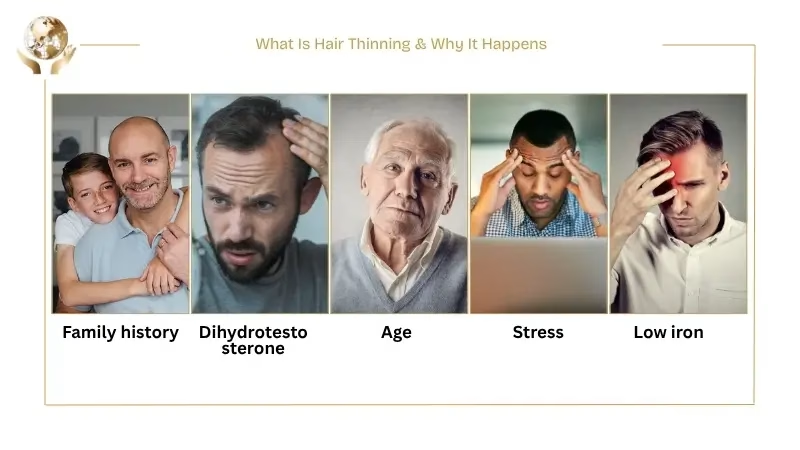
Thinning hair means that your scalp has less hair in some areas, but not completely bald areas. It usually happens slowly and most people do not notice it right away. It may affect the front, crown, or sides of the head.
In many cases, it spreads across the whole scalp. This type is called diffuse thinning.
Causes of thinning hair include:
- Family history of hair loss.
- High levels of the hormone DHT (Dihydrotestosterone).
- Age and slower hair growth.
- Stress and poor sleep.
- Low iron, protein, or vitamin D levels.
- Medical issues like thyroid or autoimmune problems.
When thinning is not treated early, it can lead to bald patches. A hair transplant for diffuse thinning adds more hair where it has become sparse. Surgeons must plan this carefully to avoid harming the surrounding hair.
A hair transplant for thin hair works best when paired with treatment for the main cause.
See Also: Visible Scalp Because of Hair Thinning
Is It Useful to Have Hair Transplant for Thinning Hair

A thinning hair transplant works when hair loss is not too rapid and is more effective when you have healthy hair on the sides and back. Surgeons take this hair and move it to thinner spots. They do not use new hair, instead they just shift your own healthy hair.
You need to wait until your hair loss slows. Otherwise, new thinning will affect areas around the transplant. Many doctors suggest medications like minoxidil or finasteride before surgery.
So, is it useful to have hair transplant for thinning hair? Yes, it can fill in your hair and give long-term results. But you must have the right conditions. You need good donor hair and stable hair loss. The results are also better when you follow aftercare instructions after surgery.
See Also: High Density Hair Transplant
Who Is a Good Candidate for Thin Hair Transplant
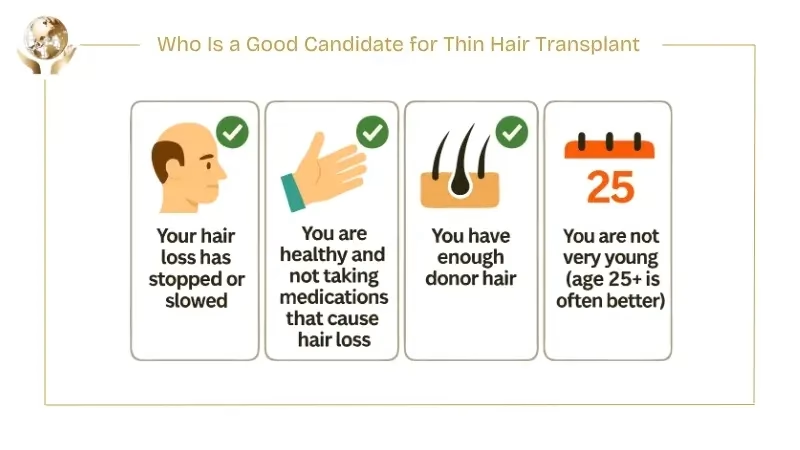
Doctors will examine your scalp, hair loss pattern, and medical history. You may be a good fit for hair transplant for thin hair, if:
- Your hair loss has stopped or slowed.
- You are healthy and not taking medications that cause hair loss.
- You have enough donor hair.
- Your scalp is not scarred or infected.
- You are not very young (age 25+ is often better).
See Also: What Is The Best Age For Hair Transplant
The back of your scalp must have strong hair, as this hair will be moved to thin spots. A weak donor area can make the result poor.
Hair Transplant Techniques for Thin Hair Areas
Doctors use three main techniques to perform a hair transplant for thinning hair. Each has its pros and cons.
| Method | Description | Pros | Cons |
|---|---|---|---|
| FUE | Takes one hair unit at a time | No line scar and fast healing | Long surgery time |
| FUT | Removes a strip from the scalp | Many grafts at once | Leaves a scar |
| DHI | Places hair directly using a pen | Precise and clean results | Costs more |
FUE and DHI are common in thinning hair transplant cases. They are less invasive and work well when hair is thin. DHI gives better control when placing hair between existing strands. FUT is used when many grafts are needed fast
See Also: Hair Transplant in Turkey
Thin Hair Transplant: Step by Step Procedure
Here’s what happens during hair transplant for thinning hair:

- Consultation: Doctor checks your scalp and explains what can be done.
- Design: New hairline or thinning zone is marked with a pen.
- Anesthesia: Local injection is given to stop pain.
- Extraction: Hair is taken from the donor site using FUE or FUT.
- Sorting: Grafts are cleaned and stored by size.
- Implanting: Hair is placed into the thinning zones.
- Bandage: A small bandage may be used to protect the site.
This process can take 5 to 8 hours and you will go home the same day. Hair transplant for thinning hair in women may take longer due to unique hair patterns.
Doctors use smaller grafts and softer angles to match female hairlines. You can wash your hair in a few days. Most people feel fine after one week.
See Also: Female Pattern Baldness
Recovery Timeline & Growth Expectations
Recovery takes time and the scalp heals in stages. Here is a clear timeline:
| Time | What Happens |
|---|---|
| Day 1-3 | Swelling and redness appear |
| Day 4-7 | Scabs form and fall off |
| Week 3-4 | Hair sheds (normal process) |
| Month 3 | New hair starts to grow |
| Month 6 | Hair looks fuller |
| Month 12 | Full result is visible |
This growth follows the natural hair cycle. Thin hair transplant before and after pictures show slow but strong results. The hair looks real because it is your own. There are minimal visible scars if done with FUE or DHI. You must avoid smoking, scratching, or harsh shampoo. Follow all advice to get a good result.
See Also: Hair Transplant Growth Chart
Thin Hair Transplant Side Effects & Risks
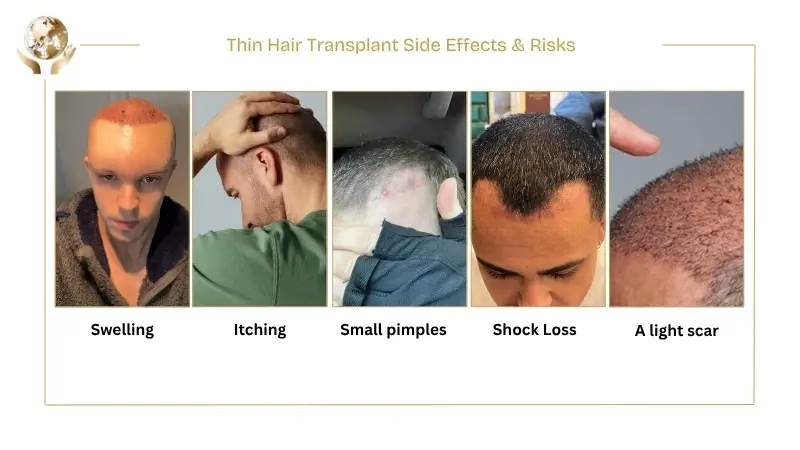
Side effects can happen after surgery, but most are mild and resolve quickly.
Common ones include:
- Redness or swelling
- Itching or tight scalp
- Small pimples or bumps
- Hair falling out in nearby areas (shock loss)
- A light scar (more with FUT)
Rare side effects include infection or bleeding. These are not common and can be prevented. You must follow aftercare instructions and take all medications your doctor prescribes. Some people may feel numb in the scalp for a few weeks.
The hair transplant death rate is very low, below 0.01%. It is a safe procedure when done at a clinic that follows safety steps. A trained surgeon will minimize the chance of any issue. Do not rub the scalp or wear tight caps after surgery.
See Also: Hair Transplant for Alopecia
Hair Transplant for Thinning Hair in Women
Hair transplant for thinning hair women is different from men’s surgery. Women often do not have bald patches. They have thin hair across the scalp. This makes donor hair harder to find. Surgeons must check hormone and vitamin levels first.
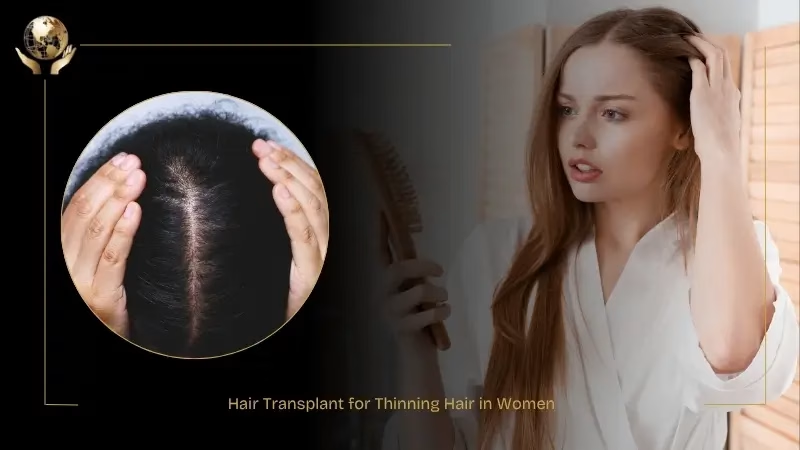
Main points to note:
- Women need small grafts to match fine hair.
- The hairline is shaped in a soft, rounded way.
- Results depend on the donor site.
- Many women use PRP and minoxidil after surgery.
The thinning hair transplant in women needs careful steps. Hair must be placed between the existing hair without harming it. Surgeons may use DHI for this because it avoids deep cuts. Women often need more time for full growth, but the results can be natural and lasting when done well.
See Also: Female Hair Transplant
Top Alternatives to Hair Transplants for Thinning Hair
Not all people need or want surgery. Here are some non-surgical options to help with thinning hair:

- Minoxidil (Rogaine) – Foam or lotion that helps new hair grow.
- Finasteride (for men) – Tablet that blocks DHT.
- PRP Therapy – Your own blood is used to feed the scalp.
- Laser Devices – Light helps blood flow in the scalp.
- Microneedling – Makes small holes to help products work better.
See Also: Can Too Much Vitamin A Cause Hair Loss?
These do not move hair or give fast results. But they can help slow the loss. You can try these treatments before getting a thinning hair transplant. Some people use both methods for better results. Your doctor will suggest the best plan based on your scalp and history.

This article is medically reviewed by Medical Aesthetic Dr. Ali Khalil (PHD)
See Our Doctors & Surgeons
How successful are hair transplants for thinning hair?
They work well in most cases. About 85–95% of grafts survive if done correctly.
How do hair transplants for thinning hair in women differ from men?
Women often have diffused loss. They need a softer hairline and careful planning.
How to prepare for a hair transplant procedure for thinning hair?
Avoid alcohol, smoking, and certain medicines. Wash your hair and eat before surgery.
What are the long-term outcomes of hair transplants for thinning hair?
The hair stays for years. It may thin with age but will not fall out easily.
How do hair transplants for thinning hair work with existing hair?
Doctors place new hairs at the same angle and space as your current hair.
See Also: Artificial hair Transplant






